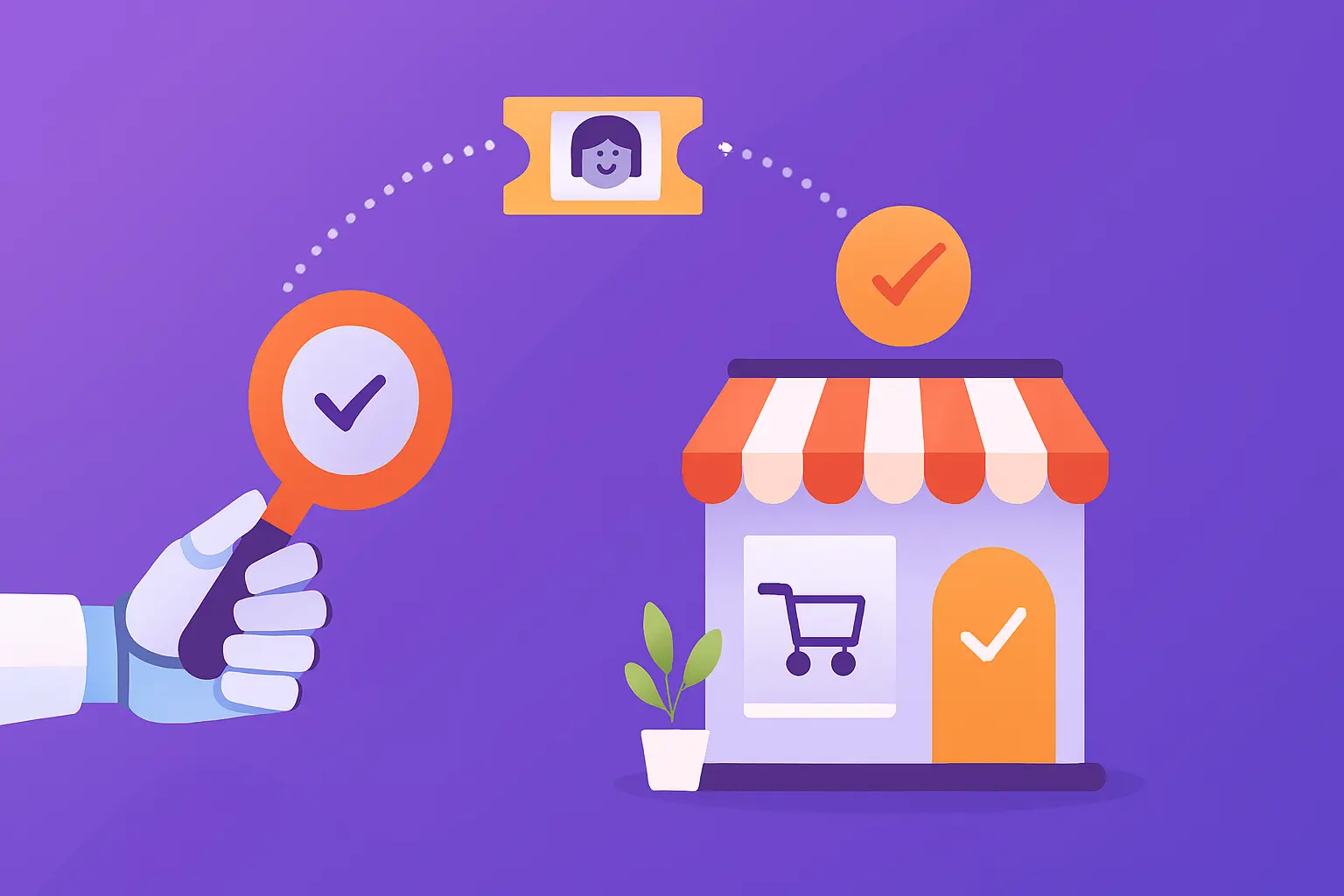Automate your customer support with chatbot integration
- October 13, 2022
- 13 mins read
- Listen
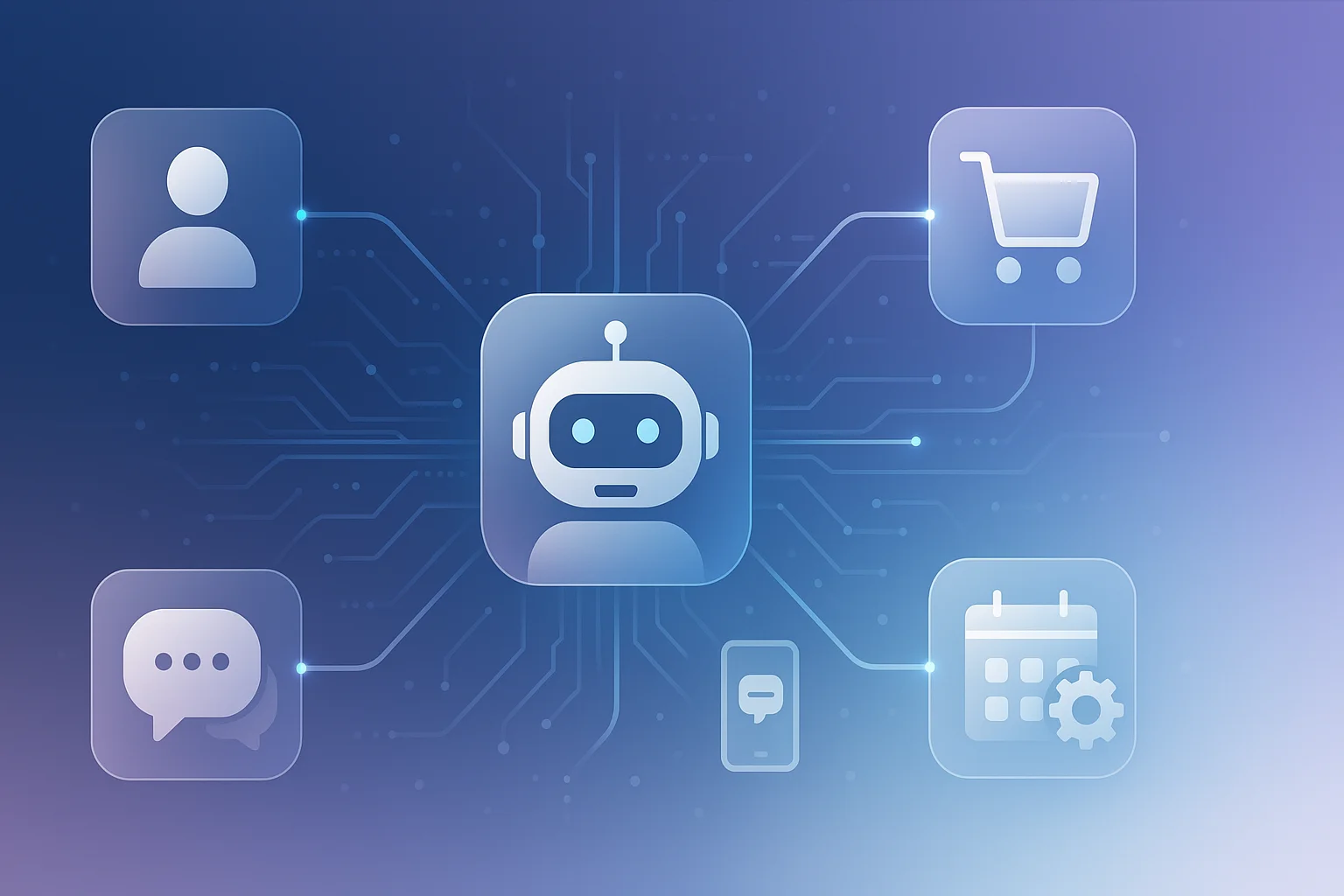
Do you know chatbot integration is getting more popular day by day? You may be wondering what the reasons are. Isn’t it? Chatbots play a vital role in delivering excellent customer service, increasing customer satisfaction rates, getting more leads and sales, and engaging customers with the business.
However, a growing number of customer service requests are coming in through messaging apps. According to recent data, more than 3 billion messages are sent every day through Facebook Messenger alone.
The same applies to other messaging apps, such as WhatsApp, Kik, Slack, Viber, and Telegram. This form of communication is becoming ubiquitous in our digitally oriented world.
That is why your business needs chatbot integration to deliver outstanding customer support quickly and effectively in all channels.
In this article, you’ll be able to learn about chatbot integration with websites, use cases, benefits, and the way to integrate.
What is chatbot integration?
Chatbot integration means you are connecting the chatbot with various platforms. It’s an entire process to deploy the chatbot with various social platforms and applications. You can integrate the chatbot with different platforms, such as websites, Apps, WhatsApp, Viber, Telegram, WordPress, Magento, Messenger, and more, to interact with visitors.
It is an automated system that can replicate the functionality of a human agent over a chat interface. It uses artificial intelligence to simulate a conversation with a real person, provides information, solves problems, and completes tasks.
Learn more about what a chatbot is and how it works.
Key advantages of chatbot integration with a website
Chatbots deliver seamless benefits for a business. Using artificial intelligence to create personalized and tailored messages not only increases your engagement with clients but also creates a better first impression for your business.
If you want to cut your operational and customer support costs, then a chatbot can be a good option for you.
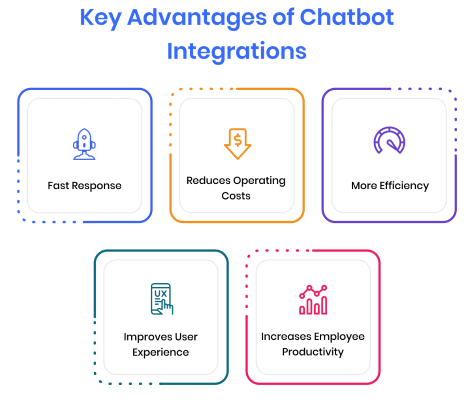
Let’s take a look at the main advantages you can get with chatbot integration with the website.
Fast response
Chatbots allow businesses to scale their customer service team by reducing the number of people needed to handle customer service. This means that businesses can respond to a larger number of customer queries than ever before.
The purpose of these tools is to facilitate communication between businesses and customers through the use of artificial intelligence. The idea is that these intelligent tools will be able to handle customer service questions easily and quickly, which is why businesses are investing in this area right now.
A recent study showed that 23% of the world’s largest businesses were currently working on some form of chatbot integration.
Some of the benefits of integrating chatbots into your business are:
- Chatbots can answer frequently asked questions
- Chatbots can respond to specific questions
- Chatbots can provide up-to-date information about the business, such as new products, services, and offers
- Chatbots can cross-sell products across the website and social media channels.
Reduces operating costs
Businesses are always looking for ways to do more with less. And in our fast-paced marketplace, there is a growing trend of companies, large and small, looking to chatbots as a way to streamline internal processes, sit down, and give their customers excellent customer service.
Chatbots are at the forefront of consumer demand, and businesses are quickly realizing the operational benefits the technology has to offer.
As customer expectations for personal, interactive digital experiences increase, businesses have been forced to allocate more resources to meet those demands.
More efficiency
Chatbot integration with the website is a simple way to increase efficiency and make a business more effective. Many businesses have implemented chatbots on their website to allow visitors to make purchases without having to contact customer service. This can be done through the company’s own website or through social media websites such as Facebook Messenger.
Chatbots are programmed to automatically interact with customers. They can be used for many purposes, like answering repetitive questions, including basic ordering, scheduling deliveries, processing payments, providing shipping updates, helping customers find what they are looking for faster, or even assisting them in making a purchase or a reservation.
Through the use of artificial intelligence, chatbots can automatically respond to customers’ queries in real-time.
Improves user experience
A chatbot, a combination of artificial intelligence and instant messaging that simulates a dialogue between people and a computing system, is often implemented as a customer service contact. It is used in situations where a sophisticated response is required, but there is no person available to respond to the customer’s questions.
With a chatbot, you can build a truly personalized and human experience for your customers. That’s because chatbots allow you to use the information that is already being collected from your end users.
So if you are asking for your name, email, and phone number during the sign-up process, those details become available on the chatbot platform. This means you can use the chatbot to interact with those customers on a more personalized basis.
Increases employee productivity
Today’s workforce is evolving. Employees are using mobile devices to engage with their business outside of the office and in more informal settings.
On the other hand, managers have to juggle different responsibilities that were traditionally performed by single employees, who were once dedicated to a specific role.
In this case, there are many benefits to chatbots for businesses, which help companies manage their operations with greater efficiency. One of them is the ability to reduce employee turnover and improve overall productivity.
- With chatbots taking on repetitive tasks, employees can focus their efforts on activities that make them unique and valuable to the business.
- Bots can follow instructions from management or be completely autonomous. In this case, employees can enjoy more free time and don’t have to jump from one task to the other, wasting their time and energy on repetitive data entry.
Know more: Benefits of chatbots for customers and businesses.
Chatbot API integration use cases
Different business verticals are fielding chatbots in different ways. And, it’s one of the reasons why chatbots can be a boon for many businesses.
There is no doubt that a chatbot is one of the best tools that businesses can use to keep interacting with customers. The bot can integrate your site so that you have as much data as possible.
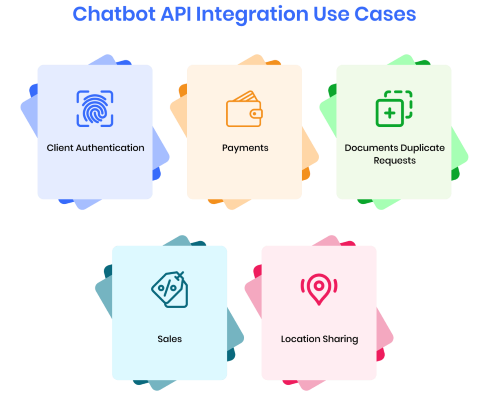
Let’s see the key use cases of a chatbot in a business setting.
1. Client authentication
The chatbot tracks the user’s interactions and passes that information to a downstream system, which is in charge of authenticating the user and creating a case. This is where business logic comes into play.
Imagine that you are a travel agency and your bot is designed to answer questions from potential customers. Once the user enters the ID number and is already registered in your company’s database, the chatbot returns a response framed with that user’s specific case.
2. Payments
From the very tangible to the very intangible, a chatbot can help you in so many ways. This is an area where using a chatbot can really improve the customer experience. By using a chatbot, you are able to reduce costs on customer support as well as provide better overall service, especially for repeat customers, such as your clients who request payment references frequently.
Similarly, when you are using a chatbot for sending requests to your customers, you have the benefit of being able to set up multiple trigger words that would activate your chatbot, allowing you to easily automate repetitive tasks such as this.
3. Duplicate document requests
Many customers ask insurers for a second copy of the vehicle certificate of registration.
Unable to receive the duplicate, they come to the service offices and simply wait in line to receive their document. To speed things up, the insurance company tried a chatbot solution. The purpose is to speed up the delivery process.
When a customer asks for a copy of the policy, the chatbot can directly send them to the right place (the website or the app) or to the right person (the agent or even the customer themselves).
There is no need for a real human to get back to you with a duplicate of your vehicle insurance policy. If everything is settled and verified, the chatbot will send the requested document by email and post.
This is the solution that has been implemented, and the results are very satisfactory for both the user and the insurer.
4. Sales
Today, many companies are using chatbots, software that functions like a virtual agent, to improve their business processes, engage with customers, and increase sales.
Customers can easily find information about products, quickly get answers to their questions, and even get a discount from the store!
Many well-known companies such as Adidas, Sephora, and Zalando use them to provide better service for clients, and more and more businesses realize the effectiveness of using them and the opportunities they offer.
5. Location sharing
Nowadays, the location-based experience has become the key differentiator for many brands, and this is even truer for e-commerce businesses. For example, each store has its own promotions and discounts, and the consumers don’t always know what is available.
A chatbot can share the location of the store with you and answer your questions, and know product availability, promos, and discounts.
The process of chatbot integration with the website
There are many different ways you can integrate your chatbot with your website. For example, you can choose to let customers know about the chatbot by placing a sign-up button on your website.
Another option is to send an email to all your website visitors, offering them the opportunity to sign up for the chatbot.
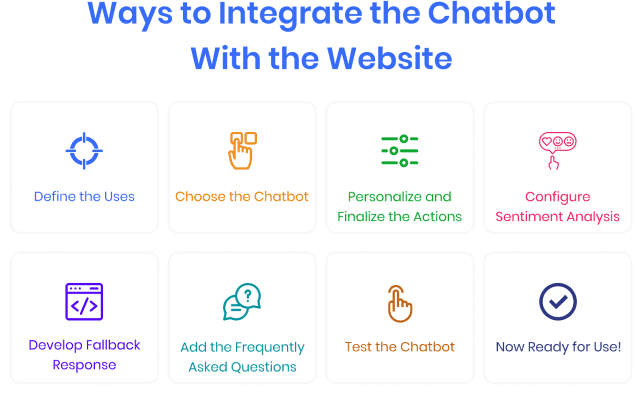
Now, take a look at the entire process of a chatbot integration with a website.
1. Define the uses
The chatbot is a software program for conversation or dialogue with the user, operated via different platforms and technologies that are currently available. These are mainly artificial intelligence (AI) and natural language processing (NLP). The chatbot can be a natural language text, speech recognition, or visual interface.
The use of the chatbot is part of the main digital strategies aimed at improving the customer experience. In this regard, it is an excellent tool to improve the quality of customer service and overcome the information asymmetries that exist.
It can be used in a range of processes, but especially in any process related to sales, customer service, and information gathering.
2. Choose the chatbot
There are many types of chatbots to choose from on the chatbot-building platform. You will have to set up a chatbot directly on a website or integrate a pre-programmed chat widget on it. You will be able to use existing code and customize it as you wish.
Make sure that you are choosing a chatbot based on your requirements and the actions you want your chatbot to take.
3. Personalize and finalize the actions
When your bot is still at the stage of development and testing, you can, of course, do a lot of things manually. But when it comes to the production mode, it is much more convenient to find a solution for automatic personalization in the form of a module or a service.
For an effective work of chatbot, it is very important to personalize its answers. The main rule here is that the response should correspond with the original text of the user. This is because a person will be looking for a particular answer and will accept only an appropriate one. Besides, if the answer is not relevant to the text, it will be considered a failure of the bot.
4. Configure sentiment analysis
One of the most crucial elements of any chatbot is sentiment analysis. It helps to engage the customers more, keep the conversation going, and provide them with a rewarding experience. The sentiment analysis also gives you an insight into how your users are responding to the content that you create, and also helps you understand their problems and issues better.
This is where it gets tricky because, in order to be able to correctly configure your chatbot to correctly identify different kinds of customer emotions, you need some help from your chatbot analytics tool.
In other words, you need to somehow make your chatbot detect when the customer is saying something positive about its features or functionality.
5. Develop fallback response
A fallback is a response that your bot will use when it doesn’t know what else to say. A conversational fallback response is what should happen if your chatbot is unable to understand or respond to a message a user is sending it. Most chatbots will display unhelpful error messages like “I’m sorry, I didn’t get that,” or “Sorry, I didn’t understand that.”.
Your customers do not want to see those generic error messages. They want their questions answered, and they want their requests fulfilled. That’s why it’s so important to include a conversational fallback response, especially when performing a task-based conversational interface.
6. Add the frequently asked questions
You know the most common questions customers ask on your websites, such as price, condition, warranty, service period, and many more.
Also, you can add these frequently asked questions and the answers to these questions in the chatbot, and this will reply to the customers based on the answer you set.
If you have a lot of customer inquiries about your product, it may take time for you to reply to all of them, but this feature will set you free from customer inquiries and focus on other work.
7. Test the chatbot
It is important for the chatbot to understand human words. If the text “Hello” is not understood properly, you will be wasting time writing specific commands each time.
If the bot gets personal information – name, address, etc., do not forget to test it with false values. The worst that can happen is that you can have several money transfers to unintended recipients.
Test each response with various combinations of parameters – all possible phrases that are used by visitors in their conversations with the bot.
8. The chatbot is now ready for use!
You have successfully completed all the features of the chatbot and have tested it thoroughly.
To use your chatbot on your website, you will need to first check if there are any changes you need to make on your site to enable it for the chatbot.
Once you have integrated the chatbot code into your website, you can now test it out and see if it works as expected. You can test it in a live environment, such as a staging site, or with the test data, you created during development.
How integrating a chatbot can benefit your business?
The world is growing more digitally dependent as people communicate via social media and instant messaging more than ever before.
Using a chatbot, it’s easy to collect information from customers and store it in a database that can be used to deliver personalized customer service.
Besides, chatbots are ideal for customer engagement and conversion rate optimization; it is far more efficient for lead generation than websites or mobile apps. Plus, if you want to get more sales, leads, and engagement, then a chatbot is the best tool.
There is no doubt that if you want to grow your business quickly, then you have to deliver excellent customer service to increase customer satisfaction and retention rate. REVE Chatbot is an omnichannel customer engagement tool that can help boost your business by delivering excellent customer service. Sign up now and enjoy a 14-day free trial.




